The village of Cwmtwrch is situated valley of the Afon Twrch, a right-bank tributary to the Swansea Valley, about 15 miles north of Swansea, and was in the heart of the coal mining industry. Nearby is the town of Ystradgynlais and the villages of Ystradowen, Rhiwfawr and Ystalyfera. The village is bisected by a now closed railway line, and its two parts are known as Lower Cwmtwrch and Upper Cwmtwrch. A newspaper report in the local newspaper, Llais Lafur, of 15 February 1919 gave details of fourteen men of the village who fell and were commemorated at a memorial service at Beulah Chapel. Other men with ties to Cwmtwrch who were not mentioned in the article are also added below. I do not currently possess any photographs of any memorials at Cwmtwrch, so any would be most appreciated.
The Great War, 1914-1918
William Lewis Edwards, Private, 040694, Royal Army Ordnance Corps. William was the son of Lewis and Hannah Edwards, of Post Office Terrace, Cwmtwrch. He worked at the Gilwen Colliery and married Rachel Ann Morgan (known as Gwen) in 1902. The couple lived in Plas y Fedwen, Upper Cwmtwrch with their three children. William enlisted at Neath at the outbreak of war, and was posted to the 12th Battalion Army Ordnance Depot, Royal Army Ordnance Corps, which was a unit responsible for the storage, issue and repair of weapons and ordnance. William served in France, but became ill towards the end of the war and succumbed to pneumonia on 31 October 1918, aged 43. He is buried in grave III.D.13. in Blargies Communal Cemetery Extension, France.
James Walter Evans, Sapper, 398112, Royal Engineers. James was the son of John and Mary Evans, of Glan-yr-Avon, Ystradgynlais. He was a tailor prior to the war and married to Dorothy Sanderson Hopper, of 7, Albion Street, Driffield, Yorkshire, in 1914. James enlisted at Birmingham into the Royal Engineers and was posted to France with the 497th Field Company, Royal Engineers, which was attached to the 29th Division. The division had fought in Gallipoli before moving to France in 1916 and saw heavy fighting on the Somme that summer. It fought at Arras and at Passchendaele in 1917 and at the end of the year took part in the Battle of Cambrai. The division moved back to the Lys sector early in 1918. James was at work behind the lines when he was badly wounded by shrapnel from an exploding German shell soon after the move north. He died of his wounds on 28 April 1918, aged 28, and is buried in grave II.H.2. in Aire Communal Cemetery, France.
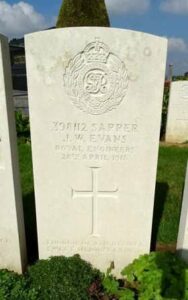
George Haydn Francis, Private, 36293, Welsh Regiment. George was the son of John and Sarah Ann Francis, of Ystradgynlais. He married Emily Ellen Earland in 1902 and the couple lived at 10, Spencer Terrace, Lower Cwmtwrch. George enlisted at Brecon into the South Wales Borderers soon after the outbreak of war, and was posted to France on 5 May 1915, joining the 1st Battalion, Welsh Regiment, which was attached to 84 Brigade, 28th Division. George joined the battalion at Ypres, in atrocious conditions, in the midst of the battle of Frezenberg Ridge. He was wounded soon after arriving at the front and evacuated to No 10 Stationary Hospital, St. Omer, where he died of his wounds on 25 May 1915, aged 33. George was buried in grave I.A.138. in Longuenesse (St. Omer) Souvenir Cemetery, France.
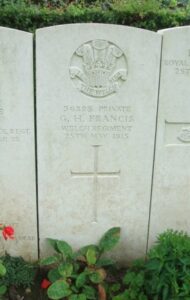
Harry Bickerdike Furness, Private, 17775, Welsh Regiment. Harry was born in Farnley, Yorkshire in 1889, the son of James Russel Furness and Mary Jane Furness. Following the death of his father in 1891, his mother married John William Givens and the family lived in 22, Nutting Road, Farnley. The family moved to Cwmtwrch prior to the war and lived at Mount Pleasant, Gurnos. Harry enlisted at Swansea into the 14th Battalion, Welsh Regiment (Swansea Pals) soon after the outbreak of war. The battalion trained at Rhyl before moving to Winchester as part of 114 Brigade, 38th (Welsh) Division and landed in France on 2 December 1915. The division was initiated into the arts of trench warfare in the Fleurbaix sector, before holding the line itself at Cuinchy, and near Neuve Chapelle before being moved to the Somme in June 1916. On 7 July 1916 115 Brigade of the division made a frontal assault on Mametz Wood but were repulsed with heavy losses, and three days later, on 10 July 1916, the attack was renewed. Harry was killed in action during the horrific fighting within the wood that day. The 28-year-old has no known grave and is commemorated on pier and face 7A and 10A of the Thiepval Memorial, France. His step-brother, William Sherlock Givens was taken prisoner by the Germans after being captured at Mametz Wood, while his step-father, John William Givens also served before succumbing to ill health in 1918.
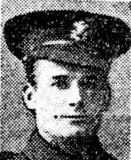
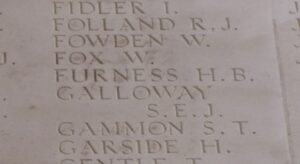
John William Givens, Private, M2/098458, Royal Army Service Corps. John was born at Wortley, Yorkshire on 23 December 1872, the son of Alfred and Hannah Givens. He married the widowed Mary Jane Furness on 22 December 1894. He moved the family to Cwmtwrch after gaining employment as a waggon repairer at the Midland Railway Yard, Gurnos prior to the war. He volunteered to serve in the army early in the war and became a driver with the Royal Army Service Corps at Marlborough, before being sent overseas on 17 July 1915 to serve in France, at Le Havre and Rouen. By June 1918 his health had begun to suffer and he was invalided home after suffering a severe bout of fever. He died at home in Cwmtwrch on 30 November 1918, aged 45. John was buried with full military honours in Cwm-Twrch Isaf (Beulah) Welsh Baptist Burial Ground. His son, William Sherlock Givens, was a prisoner of war for over two years, while his step-son, Harry Bickerdike Furness, was killed at Mametz Wood.
Lewis Holt, Private, 17809, Welsh Regiment. Lewis was born in Garnant, the son of John and Mary Jane Holt. After his father’s death his mother moved the family to Oakfield, Lower Cwmtwrch. Lewis enlisted at Ystalyfera into the 14th Battalion, Welsh Regiment (Swansea Pals), which trained at Rhyl before moving to Winchester as part of 114 Brigade, 38th (Welsh) Division. The Division had landed in France on 2 December 1915 and had spent its first winter in the trenches near Armentieres, in the Fleurbaix and Cuinchy sectors. In June the Division marched south to the Somme, where it was tasked with the capture of Mametz Wood. The attack on the wood began on 7 July, but met with fierce resistance, and it took until 11 July to finally clear the wood. Lewis was wounded during one of the attacks, and was found lying on the battlefield by Captain Arthur Smith who ordered two stretcher bearers to take him to a Casualty Clearing Station for treatment, from which he was taken to the Field Hospital at Heilly. He died of wounds on 24 July 1916, aged 22, and is buried in grave II.C.55. in Heilly Station Cemetery, Mericourt-L’Abbe, France.
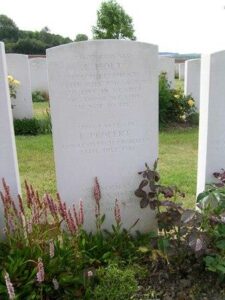
Albert Jones, Signalman, Wales/Z/3064, Royal Naval Volunteer Reserve. Albert was born on 11 December 1895, the son of Henry and Mary Ann Jones, of Gaigtredeg, Upper Cwmtwrch. He enlisted into the Royal Naval Volunteer Reserve and was posted aboard the destroyer HMS Laforey, which was attached to the Harwich Force. Laforey saw its first action during the Battle of Heligoland Bight, and on 23 January 1915, Took part in the Battle of Dogger Ban. Laforey then joined the 5th Destroyer Flotilla in the Mediterranean and helped to cover the evacuation from ANZAC Cove at the end of the Gallipoli Campaign. In February 1916 she re-joined the Harwich Force, and was sent out to escort the battleship HMS Marlborough which was returning to port with damage following the Battle of Jutland. On October 1916, Laforey was attached to the Dover Patrol and took part in several engagements over the coming months. On 23 March 1917 Laforey was escorting ships to France, and on her return journey exploded and broke in two after hitting a British-laid mine. She sunk quickly with the loss of almost 60 lives. Albert was 21 years old when he died that day, and is commemorated on panel 25 of the Plymouth Naval Memorial, Devon.
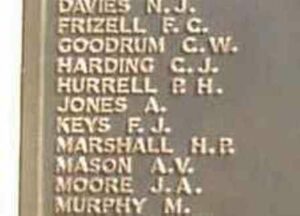
Benjamin Jones, Private, TR/5/14068, Training Reserve. Benjamin was born in Cwmtwrch in 1886, the son of David Benjamin Jones and Elizabeth Jones. The family was living in 21 Carol Terrace, Ystalyfera by 1911. Benjamin enlisted at Cardiff into the army and was posted to the 84th Battalion, Training Reserve, before being posted to the 29th Battalion, Northumberland Fusiliers. He does not appear to have served overseas, but died at Clipstone Camp on 6 July 1918, aged 32. He is buried in grave U.S.664. in Caerphilly (Penyrheol) Cemetery, Wales. Benjamin does not appear to be commemorated locally.
Harold Idris King, Private, 27780, South Wales Borderers. Harold was the son of Thomas and Caroline King, of Hazelhurst, Lower Cwmtwrch. He was a schoolteacher prior to the war and enlisted at Ystradgynlais into the Brecknock Battalion, South Wales Borderers. He embarked for overseas service in Aden with the Brecknocks, and afterwards transferred to the Devonshire Regiment, before being transferred to the 4th Battalion, South Wales Borderers. The battalion was attached to 40 Brigade, 13th (Western) Division in Mesopotamia. Harold was wounded during General Maude’s offensive towards the besieged city of Kut, in Mesopotamia. He died of his wounds on 19 February 1917, aged 21. Harold has no known grave and is commemorated on panel 16 and 62 of the Basra Memorial, Iraq.
Charlie Valentine Lee, Sergeant, 23111, South Wales Borderers. Charlie was the son of Valentine Henry and Sarah Lee, of 17, New Road, Llandeilo. He lived at Cwmtwrch prior to the war. Charlie enlisted at Wrexham into the Royal Welsh Fusiliers, but subsequently transferred into the 10th Battalion, South Wales Borderers, which was attached to 115 Brigade, 38th (Welsh) Division. The Division had landed in France during December 1915 and moved to positions around Armentieres, where they remained until moving south in June 1916, where they famously captured Mametz Wood in July 1916. The badly depleted Division was then withdrawn from the line, and sent to Ypres, and this is where Charlie was wounded, being shot through the lung. He was brought to the Casualty Clearing Station at Proven, where he died of wounds at No 46 Casualty Clearing Station, Proven on 14 October 1916, aged 26, and is buried there, at Mendinghem Military Cemetery, Belgium. Charlie is not commemorated at Cwmtwrch, but at Llandeilo. A newspaper report of his death stated that he had been awarded the Military Medal, but this was not correct.
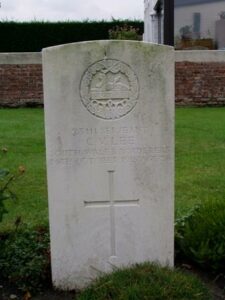
Llewellyn Tibbett Lewis, Private, 58340, Welsh Regiment. Llewellyn was the son of Edward and Hannah Lewis, of 6, Susanah Street, Cwmtwrch. He worked as a collier and was living at Castle Street, Lower Cwmtwrch when he enlisted at Brecon into the 3rd Battalion, South Wales Borderers on 24 April 1918. On 3 August 1918 he embarked for France to join the 5th Battalion, South Wales Borderers, but was instead transferred to the 13th Battalion, Welsh Regiment (2nd Rhondda), which was attached to 114 Brigade, 38th (Welsh) Division. Llewellyn joined up with his new battalion during the advance of the 38th (Welsh) Division across the old Somme battlefields, which had been launched on 21 August 1918. The battalion helped capture Pozieres and Thiepval Ridge over the coming days before taking part in the 100 days offensive which took them past Mametz Wood and Delville Wood, before capturing Morval and Sailly-Saillisel. By 17 September the division had reached positions in front of the strongly defended village of Gouzeaucourt, which it had orders to assault and capture. At dawn on 18 September 1918 the division launched its assault, and the 13th Welsh attacked African and Heather Trenches. Heavy fighting continued over the coming days, but Llewellyn did not live to see the successful outcome of the attack, being killed in action on the first day. The 21-year-old has no known grave and is commemorated on the Vis-en-Artois Memorial, Haucourt, France.
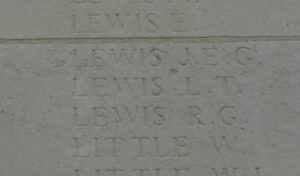
Sydney Neale Marsden, Sergeant, 14618, South Wales Borderers. Sydney was the son of William and Kate Marsden, of Rotherham. He was an army reservist, and worked as a carpenter when he married Ellen Mead in 1909. The couple were living at Gilwen Cottage, Lower Cwmtwrch by 1911, where their son and two daughters were born. Sydney re-joined the colours at the outbreak of war and landed in France on 29 November 1914, joining the 1st Battalion, South Wales Borderers, which was at Ypres attached to 3 Brigade, 1st Division. Sydney probably saw action at Ypres, during the Battle of Aubers Ridge the following year. He was later transferred to the 5th Battalion, South Wales Borderers, which landed in France on 16 July 1915 as the Pioneer battalion to the 19th (Western) Division. The battalion spent most of September 1915 stationed at Gorre, preparing for its part in a planned assault by the 19th Division on the German lines north of Loos, near Givenchy, as a diversionary attack for the main offensive at Loos on 25 September 1915. The division suffered terrible casualties during a fruitless charge at Givenchy that day, and remained in the same area while the main Loos battle raged on to their south. The 5th SWB continued its work, mainly around Le Touret, during the following weeks. Sydney was killed in action here on 29 October 1915 whilst on a working party at Gorre. The 30-year-old is buried in grave I.G.6. in Brown’s Road Military Cemetery, Festubert, France. His only son, Sidney Neale Marsden, was killed in action in Normandy on 11 July 1944.
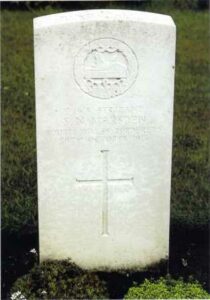
Harold Martin, Driver, 67486, Royal Engineers. Harold was born in Great Bowden, Leicestershire, the son of James and Ann Martin. By 1911 the family had moved to Crofton House, Lower Cwmtwrch, where his father had gained a position in the council, and young Harold began working underground as a miner. Harold enlisted at Ystalyfera into the 38th (Welsh) Division Royal Engineers and was attached to their 151st Field Company. The division was initiated into trench warfare near Armentieres, in the Fleurbaix sector alongside the 19th Division, before holding the line in various sectors down as far as Cuinchy over the coming months. By July 1916 the division had moved south to the Somme and took part in the famous assault on Mametz Wood. It was then moved to positions at Boesinghe, north of Ypres, where it spent almost a year before taking part in the famous assault on Pilckem Ridge on 31 July 1917. The division wintered back in the Armentieres sector, and moved back to the Somme at the end of March 1918 to hold the line north of Albert, overlooking the Ancre and Aveluy Wood. From 21 August 1918 the division began its part in the great 100 days offensive, which ultimately broke the Hindenburg Line and won the war. Harold survived all of these great battles, but took ill towards the end of the war, and died in hospital in France on 5 November 1918, aged 21. He is buried in grave XIII.N.1B. in Mont Huon Military Cemetery, Le Treport, France.
Thomas O’Connor, Private, 5347, Irish Guards. Thomas was from Tralee, Co Kerry. He lived at Ystalyfera prior to the war, and married Catherine Bowen, of Lower Cwmtwrch, in the summer of 1910. Thomas had served as a Policeman at Ystalyfera under Sergeant Bowen, for several years prior to leaving the force to work at the Phoenix Tinplate Works. He enlisted into the Irish Guards soon after the outbreak of war and on 23 November 1914 was posted to France, joining the 1st Battalion, Irish Guards, which was attached to the 4th (Guards) Brigade, 2nd Division. The battalion had suffered heavily during the early months of the war, especially during the defence of Klein Zillebeke. In May 1915, the 1st Irish Guards took part in the Battle of Festubert, and on 20 August 1915 transferred to the 1st Guards Brigade, Guards Division, taking part in the Battle of Loos in September 1915. After wintering in the Ypres Salient, the division left for the Somme on 27 July 1916 in order to take part in the Somme offensive and saw heavy fighting at Ginchy, Flers-Courcelette and at Morval. The Guards Division remained in the Somme sector over the winter of 1916-17 and followed the German withdrawal to the Hindenburg Line the following year, before being transferred back to the Ypres Salient, taking the line north of the 38th (Welsh) Division along the Yser Canal. On 28 June 1917 the battalion was in the trenches near Boesinghe, when Thomas became wounded. He was walking back to the dressing station when he was struck by a shell fragment which killed him. The 37-year-old is buried in grave 3.F.24. in Ferme Olivier Cemetery, Ieper, Belgium.
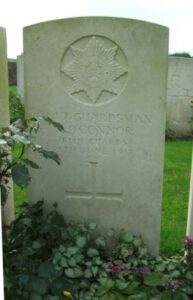
Edgar Phillips, Gunner, 156894, Royal Field Artillery. Edgar was the son of John and Rachel Phillips, of Maes-y-Gof, Lower Cwmtwrch. He enlisted at Ystradgynlais into the Royal Field Artillery and was posted to France to join B Battery, Royal Field Artillery. Edgar was reported to have served at the front for a considerable time, probably from 1916, before being invalided home as a result of suffering from gas poisoning on the Cambrai front. He died at the 3rd Northern General Hospital, Sheffield, on 14 October 1918, aged 23, and his remains were brought home for burial in Cwm-Twrch Isaf (Bethania) Calvinistic Methodist Chapelyard.
Thomas Henry Pitman, Corporal, 57583, Royal Garrison Artillery. Thomas was born at Fishguard in 1895, the son of Henry and Winifred Pitman. The family had moved to Dorset House, Cwmllynfell by 1901. Thomas became a policeman and served with the Brecon Constabulary at Brecon and then Builth Wells. Following the outbreak of war, he enlisted at Brecon into the Royal Garrison Artillery, and was posted to the 5th/6th Trench Mortar Battery. Not much is known of Thomas’ service on the Western Front, but he was killed in action by shrapnel from a German shell on 9 May 1918, aged 23. He was originally buried in Blaireville Orchard British Cemetery, but after the war the graves within the cemetery were exhumed, and Thomas was re-interred in grave VIII. Q. 27. in Cabaret-Rouge British Cemetery, Souchez, France. His father was a Royal Navy reservist who was also on active service.
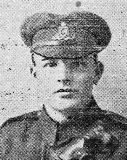
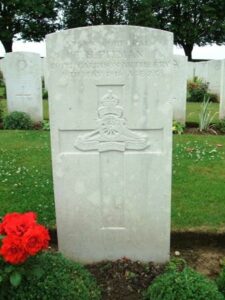
Matthew Powell, Sergeant, 6649, Welsh Regiment. Matthew was the son of Robert William Powell and Mary Powell, of Shoreditch. He had moved to Cwmtwrch to work as a collier at Rhosamman Colliery, and married Esther Frances Martin there in 1910. The couple lived at Old Lamb, Upper Cwmtwrch with their two children. Matthew was an army reservist who landed in France on 10 November 1914, joining the 2nd Battalion, Welsh Regiment, which was at Ypres, attached to 3 Brigade, 1st Division. The battalion had suffered grievous casualties during its time at the front, taking part in the retreat from Mons to the Marne, and then in a famous assault on Chivy Ridge during the Battle of the Aisne, before moving to Ypres, and helping stop the German assault on the ancient city. Matthew probably served with the 2nd Welsh during the Battle of Aubers Ridge the following year, and was most likely with the battalion during the Battle of Loos, where it again suffered heavy losses. At some time he was transferred out to the Middle East, joining the 8th Battalion, Welsh Regiment, which had moved from Gallipoli to Egypt, before being despatched to Mesopotamia with the 13th Division. Matthew became ill and died of pneumonia aboard the Hospital Ship Dongola on 20 July 1916, aged 36. He was buried at sea, and as a result is commemorated on panel 24 of the Basra Memorial, Iraq.
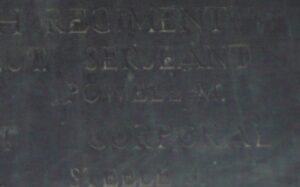
Emlyn Morgan Rees, Sapper, 146064, Royal Engineers. Emlyn was born in Victoria, Australia, on 9 August 1892, the son of Morgan and Mary Anne Rees. By the turn of the century the couple had moved back to Wales and settled at 4, Cambrian Place, Upper Cwmtwrch, then later at Bryncelyn, Rhiwfawr, Lower Cwmtwrch. Emlyn worked as a coal miner prior to enlisting into the Brecknock Battalion, South Wales Borderers on 10 October 1914. On 25 January 1916 he transferred to the Royal Engineers and was posted as a tunneller’s mate to the 252nd Tunnelling Company, Royal Engineers. During his first months in France he rose to the rank of Sergeant, while his unit carried out the secretive work of constructing underground mines and dugouts, and was the unit responsible for the construction of the Hawthorne Ridge mine, which was filmed exploding on the opening day of the Battle of the Somme. On 6 August 1917 he was reduced to Sapper for inefficiency. Early in 1918 the company moved from the Beaumont Hamel area to positions at Vimy, where it became attached to the 172nd Tunnelling Company, and became caught up in the German offensive of 21 March 1918, being engaged in defensive mining operations and facing the attack near Boursies. Emlyn was wounded during this terrible period, and died of his wounds at Doullens on 26 March 1918, aged 26. He is buried in grave V.D.30. in Doullens Communal Cemetery Extension No. 1, France.
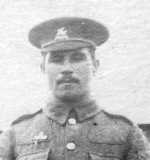
Richard Reginald Rees Taylor, Private, 125797, Machine Gun Corps. Richard, known as Reginald, was the son of William and Annie Taylor, of 6 Midland Terrace, Lower Cwmtwrch. He enlisted at Brecon into the Monmouthshire Regiment, and was posted to France, joining the 51st Battalion, Machine Gun Corps, which formed on 19 February 1918, attached to the 51st (Highland) Division. The division was in positions near Flesquières when Reginald joined it, and was hit hard by the German offensive of 21 March 1918. The battered division was moved to Bethune to rebuild and rest, but was caught up in another offensive, the Battle of the Lys, which was launched on 9 April 1918, and saw heavy fighting around Richebourg Saint-Vaast. At the beginning of May, the Division moved to Oppy near Arras, where it stayed until 11 July, but following another German offensive to the south, the Battle of the Aisne, was sent to assist the beleaguered divisions there. Reginald was killed in action on the Aisne on 28 July 1918, aged 20. He has no known grave and is commemorated on the Soissons Memorial, France.
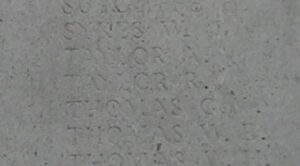
Edward John Wellstead, Private, 31341, Welsh Regiment. Edward was the son of John and Edith Wellstead, of 13, Balance Street, Julian Road, Bath. He was living in Cwmtwrch when he enlisted there into the 19th Battalion, Welsh Regiment soon after the outbreak of war. The battalion was known as the Glamorgan Pioneers and was attached to the 38th (Welsh) Division, training at Rhyl and Winchester before moving to France in December 1915. The division was initiated into the arts of trench warfare in the Fleurbaix sector, before holding the line itself at Cuinchy, and near Neuve Chapelle before being moved to the Somme in June 1916. On 7 July 1916 115 Brigade of the division made a frontal assault on Mametz Wood but were repulsed with heavy losses, and three days later, on 10 July 1916, the attack was renewed. Edward was one of fifteen men of his battalion killed during the day. The 25-year-old has no known grave and is commemorated on pier and face 7A and 10A of the Thiepval Memorial, France. Edward does not appear to be commemorated locally, even though a memorial service was held in his memory at the Cwmtwrch Mission Church on Sunday 20 August 1916.
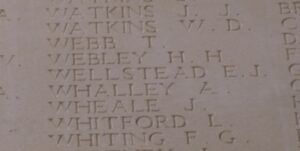
Daniel Charles Weston, Private, 17818, Welsh Regiment. Daniel was the son of Albert and Sarah Weston, of Bryn Derwen, Lower Cwmtwrch. He was one of eight men from Cwmtwrch who enlisted at Ystalyfera in November 1914 into the 14th Battalion, Welsh Regiment, which was known as the Swansea Pals, and trained at Rhyl and Winchester before landing in France on 2 December 1915 attached to 114 Brigade, 38th (Welsh) Division. The division was initiated into the arts of trench warfare in the Fleurbaix sector, before holding the line itself at Cuinchy, and near Neuve Chapelle, where Daniel was wounded by shrapnel just a month after, on 27 January 1916. He spent several weeks in hospital before re-joining the battalion in time to take part in the famous attack by the 38th (Welsh) Division on Mametz Wood in July 1916. The division was moved from the Somme at the end of July and took up positions at Boesinghe, north of Ypres, where it spent the next twelve months before taking part in the Battle of Pilckem Ridge on 31 July 1917. It wintered in the Armentieres sector before being sent back to the Somme in March 1918 to hold the stretched line north of Albert, overlooking the Ancre Valley and Aveluy Wood. From 21 August 1918 the division launched an assault across the Ancre, capturing Thiepval Ridge and Pozieres before advancing across the old Somme battlefields and driving towards the Hindenburg Line. Daniel almost survived the entire war, but was unfortunately killed by shrapnel four days before the Armistice, on 7 November 1918, aged 23. He is buried in grave I.D.18. in Dourlers Communal Cemetery Extension, France.
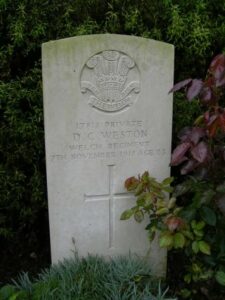
Alfred Williams, Staff Sergeant, T1/3223, Army Service Corps. Alfred was the son of Rees and Margaret Williams, of St. Mellons. He worked as a miner at Cwmtwrch prior to enlisting at Ferndale in December 1914 into the 103rd Company, Army Service Corps. He married Annie Reynolds, the daughter of William Reynolds, of 13, Spencer Terrace, Cwmtwrch in March 1915. Alfred was posted to France on 22 May 1915 with the 4th Company, 14th Divisional Train. The division saw its first action during the Action of Hooge on 30 July 1915, where it gained the dubious distinction of being the first to be attacked by the German use of flamethrowers, suffering heavy casualties in a desperate defensive action. Alfred died at No 5 Casualty Clearing Station, Lijssenthoek on 8 September 1915, aged 29. He is buried in grave III.B.36A. in Lijssenthoek Military Cemetery, Belgium.
Daniel John Williams, Second Lieutenant, Machine Gun Corps. Daniel was born in 1883, the son of Joseph and Mary Williams of Cwmtwrch. He married in 1907, and by 1911 was residing with his wife Annie Williams at Lampeter View, Lampeter Velfrey. Daniel was at the time the Headmaster at the Lampeter Velfrey Council School, then moved to Blaenconin Council School. Just prior to the war, he had moved with Annie to 93, Endelsham Road, Balham, London, and was an assistant master at a local school. Daniel enlisted in London into the 18th Battalion, Royal Welsh Fusiliers, and was soon commissioned as Second Lieutenant into the 13th Battalion, Machine Gun Corps, which was attached to the 13th (Western) Division. Daniel was killed in action during the Battle of Passchendaele on 5 October 1917, aged 35. He has no known grave, and is commemorated on panel 154-159 of the Tyne Cot Memorial, Belgium.
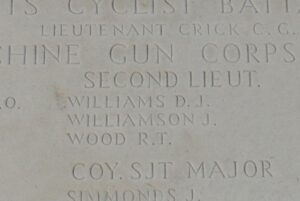
William Thomas Williams, Private, 16911, South Wales Borderers. William had served during the Boer War, and after leaving the army worked as a miner at the Cwmllynfell Colliery. He lived with his sister, Mary Davies, and her family at Lower Cwmtwrch. He enlisted into the 6th Battalion, South Wales Borderers in August 1914. The battalion was the Pioneer battalion to the 25th Division and landed in France on 24 September 1915. The division wintered in the Armentières sector, where the 6th SWB was kept busy improving flooded trenches. During the spring of 1916 the division moved into the Vimy sector, near Neuville St. Vaast and the 6th SWB worked on consolidation of mine craters and linking them by trenches. The division fought on the Somme later that year and the 6th SWB gained great recognition after digging a 700-yard-long communication trench under heavy shellfire to link up to Regina Trench. It moved north the following year in order to take part in the Battle of Messines, and in August moved further north to take part in the Passchendaele offensive. By March 1918 the division had moved south to the Somme sector and got caught up in the German offensive of 21 March 1918, losing many men in the desperate fighting which followed. The battered division was moved north, but was hit by the German offensive on the Lys on 9 April and the division suffered heavily again, being sent south to the Aisne sector to rest. Unfortunately, the Germans launched a third offensive, on the Aisne, on 27 May 1918. William was killed in action here, during terrible fighting, on 30 May 1918, aged about 38. He has no known grave and is commemorated on the Soissons Memorial, France.
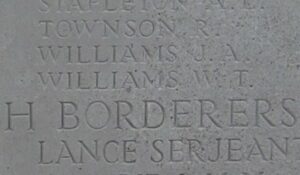
World War Two, 1939-1945
David Glyndwr Davies, Chief Stoker, D/KX 79912, Royal Navy. David was born on 11 September 1909, the son of John and Margaretta Davies, of Upper Cwmtwrch. He was already serving with the Royal Navy at the outbreak of war, and was posted aboard the Hunt class destroyer, HMS Dulverton, which had been launched on 1 April 1941. She was completed by September 1941. Dulverton was utilised for convoy escort duties, mainly escorting troop convoys bound for Suez Canal and also in convoys to Malta. In October 1943 Dulverton was involved in the Dodecanese Campaign, as part of a force that was trying to capture the Greek islands of Kos and Leros. On 12 November, she returned to support the garrison on Leros which had just been invaded by the Germans and on the following day, 13 November 1943, whilst five miles off the coast of Kos, she was attacked by German Dornier bombers and was badly damaged by a direct hit on her bridge. Seventy-eight men, including David, were killed in the explosion. Dulverton was later scuttled and sunk. David was 34 years old when he died that day and is commemorated on panel 81 of the Plymouth Naval Memorial, Devon.
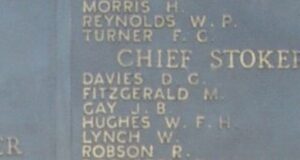
Denzil Meecham Davies, Pilot Officer, 170453, Royal Air Force Volunteer Reserve. Denzil was the son of William John and Alice Maud Davies, of Cwmtwrch. He trained as a navigator before being posted to 156 Squadron, RAF, which was an elite Pathfinder Squadron, based at RAF Warboys and equipped with the Avro Lancaster. He married Jane Nicholson, of Droitwich, Worcestershire, in 1943. Denzil took part in his first operational flight on 7 August 1943, when his squadron targeted Milan. His next raid was on 26 November 1943, when he took part in a raid on Stuttgart, and his third raid came on 16 December 1943, when Berlin was bombed. On the evening of 14 January 1944, he took off on his fourth raid, aboard Lancaster JA/975, which had been detailed as part of a force of 21 bombers to bomb Brunswick. At around 20.35 his Lancaster was intercepted by a German fighter above Holland, and was shot down and crashed near the village of Bockern, killing all her crew. Denzil and his six crew-men were originally buried in Vecht, but after the war their graves were moved to Sage War Cemetery, Germany. Denzil, who was 21-years-old, lies in grave 8.F.1.
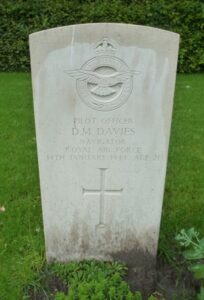
Thomas Howell Brian Griffiths, Sergeant, 1317894, Royal Air Force Volunteer Reserve. Thomas was the son of William Pryse Griffiths and Caroline Griffiths, of Sketty, Glamorgan. He spent most of his holidays with family at Cwmtwrch. After his education at Llandovery College, he became an accountant at Brynhenllys Colliery and following the outbreak of war enlisted into the Royal Air Force Volunteer Reserve. He was posted to 58 Squadron, RAF, which was attached to RAF Coastal Command, which flew anti-submarine missions from RAF St. Eval, equipped with the Avro Halifax. The squadron operated over the Western Approaches. Thomas was killed on one such mission on 27 April 1944. He was 22 years old and is commemorated on the Runnymede Memorial, England.
Thomas Edward Guppy, Private, 7608634, Royal Army Ordnance Corps. Thomas was the son of John Guppy and Mary Guppy (nee Leyshon), of Lower Cwmtwrch. He was a regular soldier, and served with the Royal Army Ordnance Corps. He was in France with the British Expeditionary Force following the German invasion of Czechoslovakia. Thomas was killed in northern France on 24 May 1940, during the retreat to the coast. The 21-year-old has no known grave and is commemorated on the Dunkirk Memorial, France. Thomas does not appear to be commemorated at Cwmtwrch.
Rhys Walter Powell, Wireman, D/MX 619718, Royal Navy. Rhys was born on 18 January 1924, the son of Griffith Walter and Margaret Powell, of Berrington Hill, Upper Cwmtwrch. He served with the Royal Navy, as a wireman (electrician) at the Combined Operations training base, HMS Dundonald, which was located in Troon, Ayrshire. Following the successful invasion of Normandy from 6 June 1944, the commando training bases began to be run down, and Rhys appears to have been among a number of men posted back aboard various craft. On 18 October 1944 he was aboard LCT 7015, which was sailing from the Clyde past Lands’ End along with several other Landing Craft, when six of them, LCT 480, LCT 488, LCT 491, LCT 494, LCT 7014 and LCT 7015, foundered and sank in heavy weather, with the loss of 48 lives. Rhys was 20 years old when he died that day and is commemorated on panel 91, column 1 of the Plymouth Naval Memorial, Devon.
David John Williams, Gunner, 108816, Royal Artillery. David was the son of Thomas and Sarah Williams, of Cwmllynfell and the husband of Mary Williams, of Swansea. He served with 172 Field Regiment, Royal Artillery, which left Britain for North African in January 1943. On 24 February 1943 the battery took part in a famous action at Hunt’s Gap, near Beja, where it was almost wiped out. After rebuilding the battery took part in the invasion of Italy, attached to the 46th Division. David was killed during the landings at Salerno on 9 September 1943, aged 32. He is buried in Salerno War Cemetery, Italy.
William Ogwyn Williams, Pilot Officer, 46839, Royal Air Force. William, known as Ogwyn, was the son of Johnny and Sarah Williams, of Cwmllynfell. He married Elizabeth Evans, of Lower Cwmtwrch, in 1941. He served with the South Wales Borderers before transferring to the Royal Air Force, possibly as a result of the death of his uncle, Siriol Williams in 1939, and in 1941 was accepted for pilot training. Ogwyn became a pilot with 106 Squadron, Royal Air Force, which was equipped with the Avro Lancaster, based at RAF Coningsby in Lincolnshire. During the night of 15-16 September 1942, Ogwyn took off from Coningsby aboard Lancaster I, Serial R5681, which was part of a force of 369 aircraft ordered to bomb the Krupp works at Essen. During the early hours of 16 September 1942, the Lancaster was brought down over Germany, killing all her crew. Ogwyn was 23 years old when he died that morning and is buried in grave 12.F.2. in Reichswald Forest War Cemetery, Germany. He does not appear to be commemorated at Cwmtwrch.